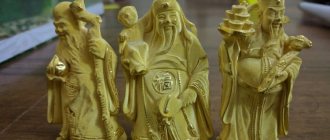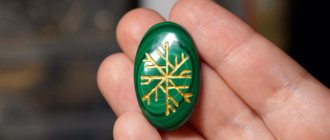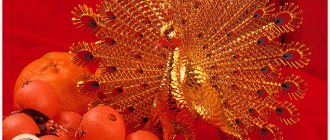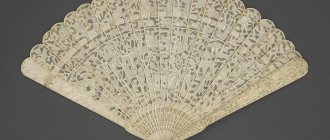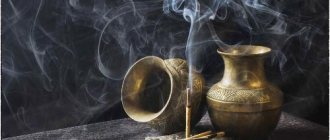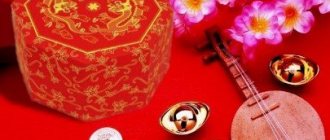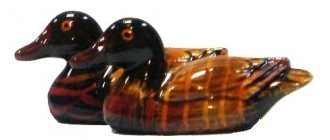Magic amulets and amulets have been used since ancient times. And they still do not lose their relevance. One of the most common and interesting ones are Buddhist mystical symbols. In this religion, talismans are given great importance. They are widespread in China, Tibet, India and other countries.
ATTENTION! If a person wears an imperial amulet on himself, he will never be poor. His debts are closed and a streak of luck sets in, which brings him into a comfortable life. With an imperial amulet, money will come in abundance - there will be much more of it than you expect... Read more"
What is the power of Buddhist amulets?
Buddhism is a religious teaching. Its founder is considered to be an Indian prince named Siddharth Gautam. Upon reaching the age of thirty, he renounced rule and family and set out to search for the meaning of life. There are various Buddhist amulets in Buddhism. The materials for their manufacture are wood, stone, clay or paper. The most powerful amulets are those made of silver or gold. Also, many symbols in Buddhism are applied to the body in the form of tattoos.
These talismans have the following purposes:
Talismans help achieve inner harmony
- protect from evil forces;
- achieve inner harmony;
- destroy harmful effects on energy;
- receive luck, material wealth and health.
These amulets must be consecrated by lamas in monasteries. Special rituals are performed on them, after which these objects become powerful protective symbols.
Features of religion
Buddhism is a doctrine of spiritual awakening practiced by many peoples with different traditions and cultures.
The founder of the religion is considered to be Siddhartha Gautama, who was later named Buddha. They practice the Buddhist faith in Mongolia, Tibet, India and China. In each country, the fundamentals of religious teaching are different, but despite the differences, they are based everywhere on 4 noble truths:
- Everything is dukkha. Frustration, anxiety, fears, dissatisfaction, etc.
- Dukha must have a cause.
- You can get rid of dukkha by solving the cause.
- The path to get rid of it leads to nirvana.
Adherents of this religion are always calm and peaceful.
The main distinguishing features of Buddhists from people professing other religions are calmness and tranquility, peacefulness and a smiling face. It is believed that the basis of life is suffering, which arises from human desires, and the soul passes from one body to another every time. Therefore, all forms are transitory. Another important religious tenet is the slogan “What goes around comes around.” That is why the life of those who profess faith is based on the performance of good deeds and the renunciation of violence, alcohol and drugs.
Figurines of Buddha and his prototypes
Images, figurines of Buddha or other cult personalities are often used as talismans. Such products are made of clay, metal, and painted on canvas or paper. Buddha is the personification of devotion to faith, the search for true paths that will help get rid of earthly suffering.
Tibetan lamas and other adherents of this religious teaching believe that there are certain deities who are endowed with a higher mind. Buddhist magical amulets include:
Amitayus increases human internal energy resources
- Samantabhadra. It is the Buddha who enlightens, who reveals the true state of things;
- Amitayus. Increases a person’s internal energy resources, helps get rid of various ailments;
- Amitabha. This is a symbol of achieving Nirvana, helps the soul to be successfully reborn in the flesh;
- Mahakala. It is a strong amulet against evil spirits and helps maintain health;
- White Mahakala. It is a powerful protective symbol for its owner;
- Chakrasamvara. Helps you discover new abilities;
- Vaishravana. Helps increase financial well-being;
- Trimurti. He is a triune Buddhist deity, thanks to whom one can protect oneself from illnesses;
- Vajrakilaya. This is an angry deity who will help protect against damage, the evil eye, and negative magical influences;
- Shakyamuni. It will help on the path of self-knowledge and self-purification.
Manufacturing materials
In the manufacture of accessories, materials of natural origin are used. Tibetan monks prefer metals:
- gold;
- silver;
- copper;
- iron;
- lead, etc.
Each material is designed to improve some aspect of life. Gold is used to create amulets to attract financial well-being. Iron promotes health.
Combinations of metals are also used. When making a talisman at home, it is recommended to choose wood.
Plant and animal amulets
The lotus represents wisdom, enlightenment, perfection
Adherents of Buddhism have always been kind to representatives of flora and fauna. Among them, many plants are considered sacred and are depicted as protective symbols:
- lotus is a water sign, personifies wisdom, enlightenment, perfection;
- goldfish - a paired talisman that helps prevent disagreements in the family and attracts financial stability;
- elephant - identified with spiritual perfection;
- the tiger is strength and power;
- The cat is the personification of the hearth and protects the family.
Most often, animalistic amulets are applied to the body and made in the form of figurines. They are placed in the house in order to cleanse it of negative influences and attract good luck and prosperity.
Magic crafts made from dough with salt
Using salt dough is a long-standing tradition. The Slavs associated their strength with three main components: water, salt, flour. Anyone can make a talisman:
What to sculpt, choose for yourself. Popular:
You can make a beautiful amulet from dough with children; it will become reliable protection for the whole family and home. You should know that if a figurine is broken, you need to get rid of it - bury it.
Mandalas
People who are not associated with Eastern beliefs and traditions can use mandalas as protective symbols. These are special patterns and images that are used in a toga to concentrate thoughts and spiritual improvement.
Mandalas are used as protective symbols
The symbol of the model of the Universe are special geometric figures that are used in mandalas. They have a complex structure, they personify the interconnection of all processes in the Universe. Such talismans are used to improve your health and strengthen your energy.
Immutable rules
It’s not enough to give a scarf – you have to present it correctly.
It must be served only with both palms, with the thumbs supporting the upper part. The material must be clean, smoothed, folded in two even layers. It should be held with the outer side facing the person being congratulated.
It is equally important to accept the precious gift correctly: with both palms, with a slight bow and touching the forehead to the fabric. The donated item can be worn around the neck without tying it, or put away in the bosom, after carefully folding it.
When welcoming a guest into your home for the first time, you need to show hospitality and offer white treats on a silk scarf. There may be tea or money nearby.
Hadaks love order. It is believed that a person who knows how to keep them clean also knows how to save and multiply money. Neat people keep them on the altar, next to sacred objects, away from debris and dust.
Scarves received as gifts can be re-gifted, and can often be found tied to shrines, statues, trees, and monuments.
On the coat of arms of the Buryat Republic you can see this most interesting element - a blue ribbon on the bottom of the circle, which reflects the openness and love with which the Buryats receive guests.
Other types
There are also other varieties of Buddhist symbols:
- Om sign. This is a sacred syllable. In Buddhism, it is believed that the entire Universe originated from it. It is written down on paper or wood;
- white umbrella – is a protection against negative thoughts, depression, emotional decline;
- bowl – protects against diseases, gives longevity;
- white shell - personifies purity and pleasure;
- knot - is a symbol of endless life, helps to direct energy in the right direction;
- victory banner - helps to overcome internal obstacles;
- the wheel of samsara - helps to gain wisdom;
- diamond talisman – is a powerful protective symbol;
- Dzi beads - protects against evil forces;
- red thread – protects against diseases and negative energy.
general information
A variety of Buddhist amulets
An analogy for angels in Buddhism are Siddhas. They are supernatural mythical forces with impressive magical abilities. Sometimes this name is used to call Mahasiddhas - great yogis and thinkers of Buddhist culture, but over time this concept changed and siddhams began to call the possibilities hidden in the human body, to reveal which it was necessary to know the Buddha and one’s inner world.
Over time, they acquired significance as conductors of the powers of knowledge and amplifiers of the siddhas of the human body. In fact, these are the same ethnic amulets inherent in any of the cultures of the world, but with their own specific religious characteristics. The main nuance, little understood by our people, is that there are a lot of Buddhist practices. Christianity in this regard is no different, but in it separate names have been invented for each of them, so the Orthodox do not identify themselves with Catholics or Protestants, but in Buddhism - everyone is Buddhist.
Important! The practices of Buddhism are not separate branches of belief; they are ways of achieving certain stages of knowledge through which each master of a given cult passes.
How Buddhists Advise Using Symbols
It is recommended to place the figurine in a place that is significant to the person.
There are many different uses of Buddhist symbols. The use is determined by the type of talismans and their purpose. There are general rules for using such items:
- amulets in the form of pendants, bracelets or rings should always be worn on the body without taking them off;
- It is recommended to place the figurine or figurine in a place that is significant for a person in the house or workplace;
- to protect your home from evil, it is recommended to hang a Buddhist symbol on the external wall of the house;
- amulets can be hung inside the home, near the front door, windows;
- install on the car dashboard, on windows to protect against accidents;
- apply sacred Buddhist symbols to the body in the form of a temporary or permanent tattoo;
- set at work to improve material well-being and relationships with colleagues.
It does not matter how and where to place amulets for personal use. The main thing is that they are chosen correctly and made in accordance with the canons.
Operating principle
Tibetan sacred symbols:
- They change their worldview and value system . Amulets make you rethink current events and feel responsible for your actions. It is not wealth that brings satisfaction, but the opportunity to help someone.
- Protect from negative influences . Sacred signs prevent enemies from causing harm and help end dangerous relationships.
- Attract favorable opportunities . Unexpected meetings and new acquaintances allow you to fulfill long-standing desires and implement projects.
Tibetan sacred symbols protect against negative influences.
Rules for choosing a personal Buddhist talisman
For an item to become your reliable assistant, it must be charged
In order for the selected item to become your reliable assistant, it must be properly charged. Special rituals are performed and prayers are read over this symbol. Remember that if you purchase a souvenir in a retail store, it will not have protective functions. Monks do not have the right to sell amulets. They can only charge a rental fee for using the artifact.
When choosing a Buddhist amulet, it is best to consult with the temple servants. The image itself, as well as the material from which the amulet is made, is of no small importance. An amulet made of paper or wood will easily give off its positive energy, will create comfort, and is suitable for home use. Wooden amulets are considered more effective. You need to choose a metal carefully, since a certain planet of the solar system is the patron of each metal.
It is not recommended to purchase several types of Buddhist amulets at once, especially if they have different energies and have different purposes. It is important to concentrate on your most important desire, for example, in order to recover from a disease, you need to select several symbols that are designed to improve health.
By carefully choosing a Buddhist amulet and taking it seriously, you can achieve success in the necessary area of life. Magic objects help individuals seeking self-development and self-improvement. Their energy should not be directed towards worsening the well-being of others.
Popular amulets
Buddhist talismans are not only wearable jewelry, but also statues, images on paper (similar to Christian icons), drawings on walls and cast metal panels. The most popular are:
Diamond protection is a paper amulet with a black and red image printed on it. The most powerful Buddhist amulet of success. It protects not only the owner, but also his thoughts.
The amulet of a Thai monk is a talisman designed to protect the consciousness of the owner. It is produced by applying an image to paper with a special fur brush.
Double Dorje is a symbol of connection with Buddha Amoghasiddhi and his protection.
Bodhisattwy Ksitigarbhy - is a piece of fabric with the mantra of the same name written on it. The combination of blue fabric and white paint is considered classic.
The amulet for resolving karmic debts is a white sheet with the mantra of the earth painted on it in red paint.
Amitabha is a mantra depicted in red paint on white paper, but after wearing it, it must be burned in a special bowl to say goodbye to karmic debts.
Doors - in this case, the Padmosnisha mantra is applied to the paper, designed to help the owner control his spirit and achieve enlightenment.
Therma Padmasambhava is a text amulet with a “spell” applied to the fabric in black paint, which helps protect oneself from external evil.
Buddhist amulets differ significantly from classical Slavic amulets, so to use them you need to carefully approach the issue and understand the subject. It is necessary to understand what Buddhism is and what religious rituals are characteristic of this belief.

